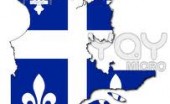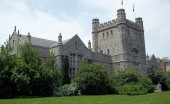Molly Minturn - My family is heartbroken to share that my father died in surgery on Monday, Feb. 10. It…
Gary Gallon on the Ice Storm
Written by Diana Thebaud Nicholson // January 12, 1998 // Natural Disasters, Wednesday Night Authors // Comments Off on Gary Gallon on the Ice Storm
The Ice Storm: A Beautiful Disaster
by Gary Gallon
reprinted from The Globe and Mail, January 12, 1998
The ice rain was beautiful. It wrapped a lustre around the tree branches giving them the aura of ice queens. I walked the streets marvelling at the crystal arches created by the branches bending under the weight of the rain that froze. It coated everything like glass.
Every year in Montreal we get a day here and a day there of ice rain. The rain comes down as water and freezes like concrete on contact. Trying to scrape it off the car windshield, made me appreciate its strength. Ice rain is like crazy glue. You have to jack hammer it off.
Each year a few branches break. On the first day of the “Great Ice Storm of ‘98”, that’s what happened. Mothers took their children out on the streets just to look at the wonder. Squealing as another light branch broke and sent twigs and ice sprinkling to the ground.
On the second day, the storm didn’t go away. Things got worse, much worse. The crazy glue kept falling. Tree branches were wrapped with hundreds of pounds of ice. It wasn’t funny anymore. Then we began to hear the cracking outside our homes. It was like gun fire. But the dead were not people. They were trees.
A wholesale destruction of trees began. We woke up in the morning to find broken trees everywhere. Hundred-year old trees in Notre Dame de Grace (NDG) and Westmount, three feet in diameter at the base, were losing one-feet thick branches. Branch after branch broke, leaving a circle of matted wood around the trees.
The tragedy of the ice storm is the massive destruction of trees. By the third day of the storm, many trees had been split and collapsed by the ice. Once grand trees had lost more than half of their branches. Walking block after block, I would look up and see stumps where once limbs had been. Initial estimates are than more than two million trees have been damaged. It’s a disaster. It will take more than a decade to recover the strength and beauty of our urban forests. Most of the problems for Montrealers were as a result of the falling branches. The branches brought down powerlines and transformers, cutting off electricity to regions and to homes. The branches smashed cars. They fell on people. The branches being torn from the limbs of the trees became dangerous missiles as they plunged to the ground.
We had to move our car from its normal spot because the foot-thick branches on our neighbour’s tree were threatening to break. They loomed like darkness over our driveway. So strange, for these were the same branches we loved for their foliage in the spring. The neighbour wouldn’t let her daughter walk over to our house fearing she would be harmed by the falling branches.
I took the dog out that night, like I did every night. Tree branches were down everywhere. Cars were covered, some were damaged. The sidewalks were impassable. We had to walk in the street. Some streets were blocked. Hydro crews were wielding chainsaws, cutting up the trees resting on the powerlines and laying across the roads. I trotted past the threatening trees. The dog didn’t care. She sniffed the branch stumps as if attracted by the smell of death.
We went to our favourite park. The police had put up those yellow crowd control tapes that blocked our entrance and warned not to enter. Beyond the tape the park looked like a war zone. Broke trees rose like skeletons in the mist of the ice rain that was still falling. Dying branches littered the landscape. The outdoor ice rink was covered. The playground equipment was buried in branches that, by themselves, were as large as small trees.
We walked in anyway. When the wind blew through the trees I heard the klinkeling of what sounded like a hundred chandeliers. It was the cracking of the ice around each of the branches. The ice cracked by didn’t let go, not until it brought down the branch. I halted my walk through the park at the point where I found a large branch broken and fallen on an electric wire strung to one of the houses next to the park. The lights were out in that house.
It was like that all down the street. The unlucky homes were dark — their electricity wires cut and their phone and T.V. cable wires ripped down. I saw the neighbourhood light up with blowing transformers and hot wires. At the height of the storm, more than a million homes in Montreal and surrounding communities were without electricity. More than 5,000 Quebec Hydro employees were mobilized to clear the tree branches and repair the wires. Crews were brought in from as far away as Long Island, New York. Five deaths were attributed to the storm.
As we walked back to our house, at 11:30 pm, I discovered that once side of our wooden fence that I had built in the summer had been smashed by a branch. It lay there big and unmovable, coated with a glistening skin of ice that didn’t even let during the fall. I couldn’t stop marvelling at its beauty. And I couldn’t stop thinking what a disaster it was.
It was like the Titanic. You are living in it. You can’t believe it’s happening. It was a beautiful disaster.


